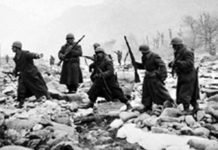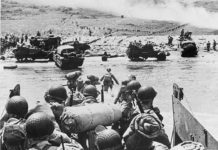The Falklands was a defining naval battle at the opening of the First World War using a new concept of warship. But how and why did it come about?
On the outbreak of war in August 1914, Germany only had one fleet of warships outside of European waters, the East Asiatic Squadron under the command of Vice Admiral Graf Maximilian von Spee based in Tsingtao in China. The squadron consisted of the powerful armoured cruisers Scharnhorst and Gneisenau and the light cruisers Leipzig, Nurnberg and Emden with their supporting colliers.
Von Spee held a council of war with his captains to decide what steps he should take against the British before he was inevitably caught and destroyed by a superior British squadron. Retreat to Germany was impossible so the decision was that the ships should remain together as a fleet in being, to carry out such commerce raiding as was possible.
Capitan von Muller of the light cruiser SMS Emden disagreed and argued that he should be detached the sail into the Indian Ocean where he could carry out commerce raiding against the British merchantmen. Von Spee agreed and Emden together with her collier Markomannia were detached from the squadron.
The remainder of the squadron with Vice Admiral Graf von Spee flying his flag in SMS Scharnhorst sailed towards South America and off Coronel on the Chilean coast he met an inferior British squadron under Admiral Cradock.
The fight was short and vicious and due to the superior German ships with efficient trained crews, it was inevitable that the British were destroyed with the exception of the light cruiser HMS Glasgow who managed to escape with an auxiliary cruiser the converted liner HMS Otranto.
Fisher Returns to the Admiralty
Admiral Sir John Fisher had been First Sea Lord from 1904 to 1910 and was recalled by Churchill only days before. One of his first actions was to remove Admiral Sir Doveton Sturdee from his post as Chief of War Staff. Pompous and never willing to listen to anybody else’s opinion, Sturdee had always been opposed to Fisher’s reforms when he was previously First Sea Lord.
The Admiralty was furious with the defeat and Fisher took decisive action. Two battle cruisers HMS Invincible and HMS Inflexible were detached from the Home Fleet and sent South under the command of Sturdee. He was not one of Fisher’s first choices to command, but there was no-one else available.
Sturdee was under orders to proceed South at the utmost speed, to find von Spee and destroy him, so the ships he was given were fast. The battle cruisers met up with the squadron of Rear Admiral A. P. Stoddart with 3 armoured cruisers HMS Carnarvon, Cornwall and Kent, 2 light cruisers HMS Bristol and Glasgow and one auxiliary cruiser. Together they arrived in the Falklands on the evening of the 7th December 1914, 4 days later than the Admiralty expected Sturdee to arrive.
It was Fisher who had invented the battle cruiser concept, they were designed to carry the main armament of a battleship but to be much faster, so they could dictate the time and place of battle. To ensure they had the machinery to produce such speeds they were very long, longer than a battleship but with much less armour and the lack of armour contributed to their speed. For this reason they could overhaul light cruisers which were designed as commerce raiders but could not compete with battle cruiser guns. They could take their place in the line of battle, but they were vulnerable to the heavy guns of the battleships.
Sturdee was to carry out an action that would prove the worth of the battle cruiser concept. But first he had to find von Spee, bring him to battle and destroy him.
Von Spee catches the British Unprepared
Von Spee had decided to sail to the Falklands to destroy the radio transmitter and fill his bunkers with coal; he arrived early in the morning of the 8th December 1914. He could not see the harbour due to low hills surrounding it, but he would be able to see the masts of any ships protruding above the land.
Sturdee knew that he was hunting a powerful German squadron, he knew their worth from the Admiralty reports, their success against Cradock at Coronel and Glasgow who took part in that action was now with him. But inexplicably he had allowed all his ships to coal. He had made only bare arrangements for the security of his squadron with an armed merchant cruiser Macedonia patrolling outside the entrance of the bay. Only HMS Kent who was due to relieve Macedonia was able to raise steam within two hours.
By 5.30am on the 8th, Invincible was attached to her collier and all hands were coaling. Two hour later they were piped to breakfast having only loaded about 400 tons. It was then that the lookouts first saw the smoke from the German warships.
The lookout signalled to Canopus an elderly battleship which had been beached in the bay and acted as a gun platform, that there were two unidentified ships and Canopus signalled to Glasgow in the bay a simple message ‘Enemy in Sight’. Glasgow could see Invincible as she was hidden under a cloud of coal dust and her repeat signal was not read. Captain Luce (Glasgow) ordered the signal gun fired to attract attention and then by using his searchlight he passed the message.
Invincible, Inflexible, Carnarvon and Cornwall were in Port William and Bristol and Glasgow were in the inner harbour near to the Canopus. By 8.00am only Carnarvon and Cornwall had completed coaling, Kent, Cornwall, Bristol and Macedonia had not yet started. Carnarvon’s decks were covered with bags of coal. Bristol and Cornwall had parts of their engines dismantled for boiler cleaning. Kent was the only ship ready to fight.
The German squadron had they known what really was happening inside the bay, could have stood off and shelled the British warships and executed much damage. Von Spee also had an alternative of waiting for the British ships to leave the narrow harbour entrance and then subjected each one to a hail of shells as they appeared.
At 8.10am flags were hoisted up the halyards as Invincible signalled to the rest of the squadron. Kent was ordered out to protect Macedonia. The battle cruisers cast off their colliers and all ships were ordered to raise steam. Carnarvon was to sail as soon as possible and engage the enemy “as soon as they come around the corner”, Macedonia would return to the harbour and Canopus was ordered to open fire immediately.
Thus the battle began.
Sources
- Jellicoe, Adm J. The Grand Fleet 1914-1916 Cassell & Company 1919
- Grove, E. (Ed.) Great Battles of the Royal Navy Arms & Armour 1994
- Massie, R. K. Castles of Steel Jonathon Cape 2004








